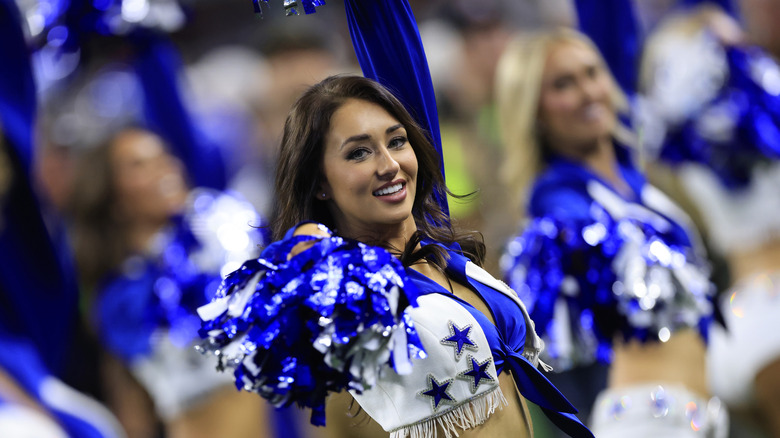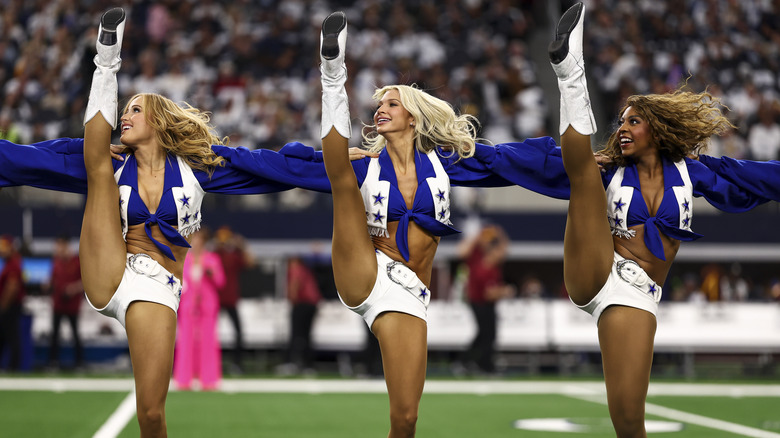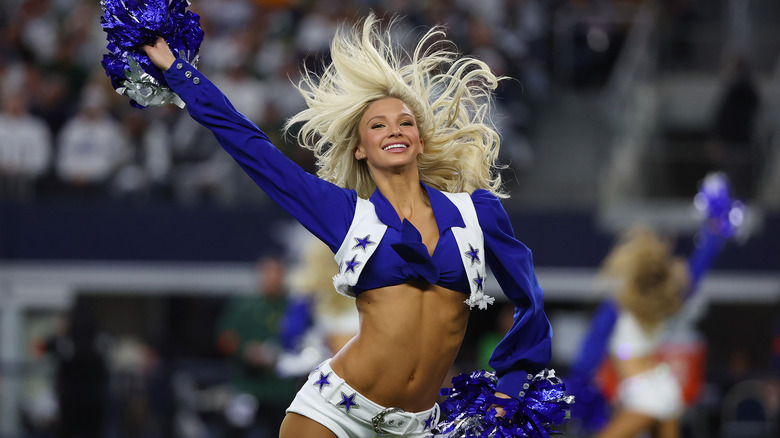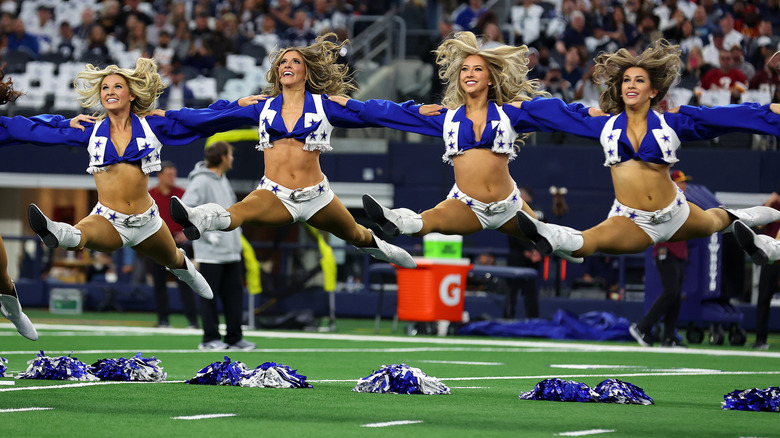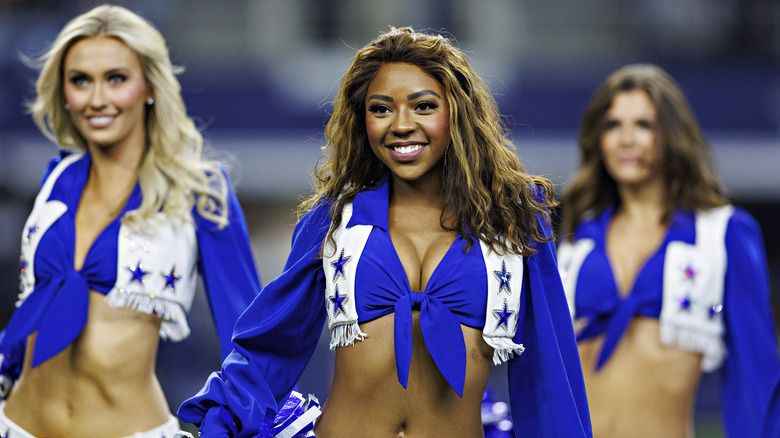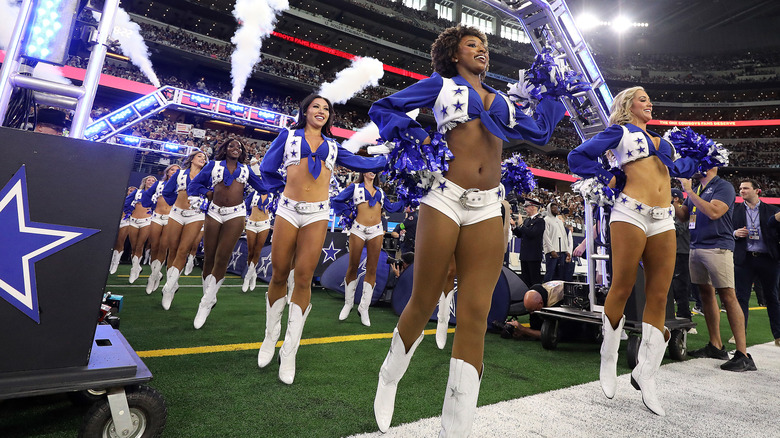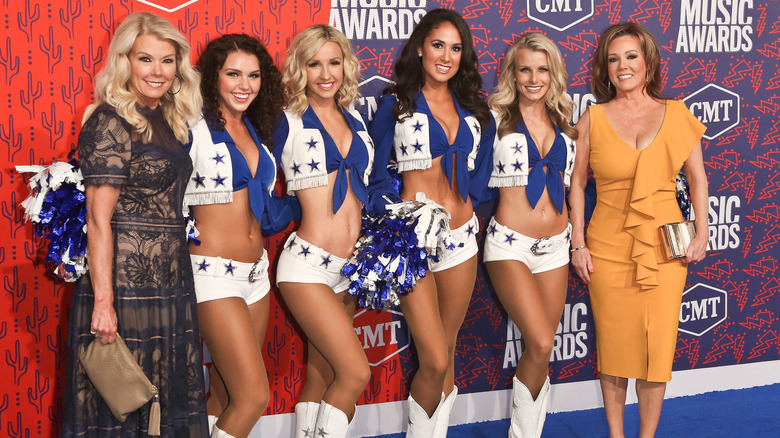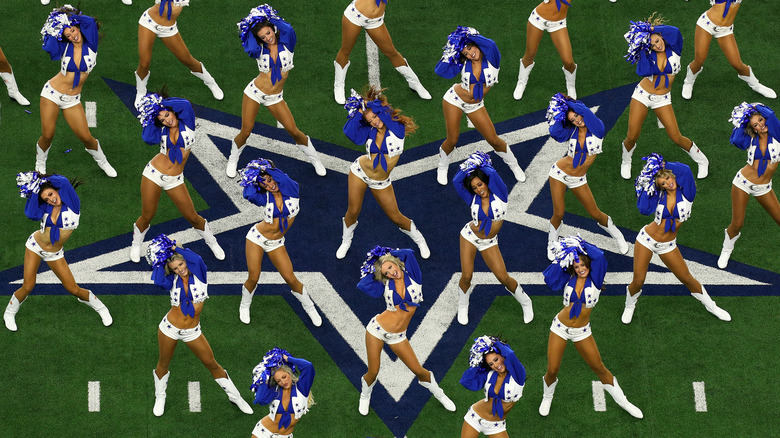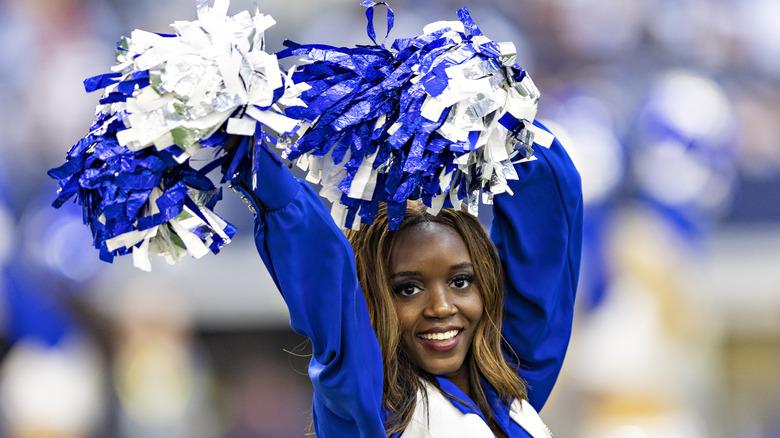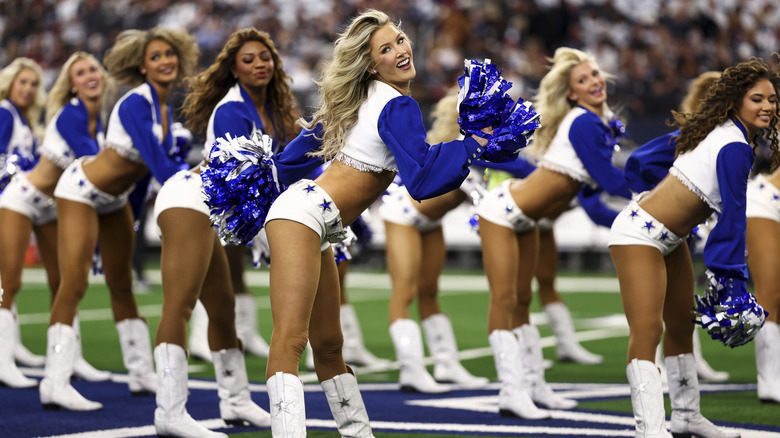The Dark Side Of The Dallas Cowboys Cheerleaders
What happens when your wildest dream becomes a reality? For the hopeful dancers of the NFL's most prestigious cheer team, the Dallas Cowboys Cheerleaders, the dream can quickly become an overwhelming nightmare.
Founded in the 1960s, the Dallas Cowboys Cheerleaders, or the DCC, have become iconic symbols of American culture, values, and visual appeal. While the team has always been elite, the standards of athleticism, beauty, and talent have only gotten stricter since the introduction of the iconic blue-and-white starred uniform in the 1970s. Led by director Kelli Finglass and choreographer Judy Trammell, the selective, months-long audition process was meticulously documented on the CMT reality television series, "Dallas Cowboys Cheerleaders: Making The Team," until its cancellation in 2022 after 16 seasons. In 2024, a Netflix docuseries titled "America's Sweethearts: Dallas Cowboys Cheerleaders" picked up where the original series left off — but, this time, hearing the truth from the cheerleaders about their behind-the-scenes struggles.
Needless to say, both series shocked the nation by highlighting some of the dancers' never-before-seen hardships — including harassment and just how little they are paid. Let's jump into the dark side of the Dallas Cowboys Cheerleaders.
High standards, low pay
It's no secret that becoming a Dallas Cowboys Cheerleader can be an immense privilege. Many dancers spend their entire lives training for auditions, and some will try out multiple times before finally making it on the team — if at all. In return, they're revered as global icons, and some cheerleaders even go on to be celebrities themselves. But, despite being one of the most prestigious cheerleading squads in the world, the DCC has been highly criticized for unfair labor practices and low pay.
While NFL football players make millions per year – take Cowboys quarterback Dak Prescott's lavish life, for example — the cheerleaders are estimated to make a measly $500 per game and $15-20 per hour for practices. "They're not paid a lot," Charlotte Jones, CBO and daughter of Cowboys owner Jerry Jones, said in the "America's Sweethearts" Netflix documentary (via HuffPost). "But the facts are that they actually don't come here for the money. They come here for something that's actually bigger than that to them." What exactly is this bigger purpose, then? "Sisterhood" and "passion," Jones justified.
Many, if not all cheerleaders work full-time jobs on top of being a DCC in order to survive. In 2018, former cheerleader Erica Wilkins took a stand and sued the Cowboys organization for wage theft. After a year of appearances, calendar shoots, and performances, Wilkins claimed she only made a measly $4,700 after taxes.
Toxic body requirements
To be a Dallas Cowboys Cheerleader, you must acquire three things: the talent, the dedication, and, of course — the look. Consisting of voluminous hair, impeccable makeup, and rock-hard abs, the DCC look is unique — and certainly doesn't come easily. With the constant reminder that the revealing uniforms leave nothing hidden, the girls are put under an intense microscope and are subject to scrutiny from director Kelli Finglass and choreographer Judy Trammell at any time.
Before even making the team, DCC newbies are stripped of their every day looks and given a bombshell style makeover. But, "We don't have a stipend for anything," former cheerleader Erica Wilkins told the New York Post. Wilkins explained that once on the team, each DCC is expected to maintain and fund the upkeep of said makeover, which can be quite expensive. Additionally, throughout a cheerleader's time on the team, she is expected to maintain her audition weight. "Once you're fitted for that uniform, that size is the size that you get. You don't get to go up," said one squad member in the Netflix documentary (via People). The rule is strictly enforced: if you don't meet your weight requirements, your position could be at stake.
The pressure of maintaining such standards can leave devastating scars on the girls. "I didn't have body image issues until I became a Dallas Cowboys Cheerleader," an ex-cheerleader told the Daily Mail. Because the cheerleaders aren't provided health insurance, many suffer from mental illness and other hardships without access to support.
Dangerous stunts lead to serious injuries
Despite the glitz and glamor associated with being a Dallas Cowboys Cheerleader, many women will endure less-than-glamorous injuries throughout their time on the team. Perfecting the DCC's unique dance style can be challenging, as it requires not only talent and skill, but also incredible resilience and strength. The cheerleaders' rigorous training involves high-energy routines, choreography, and stunts — all while maintaining a beaming smile and almost inhuman levels of fitness and beauty, and most importantly, avoid getting hurt.
Most notably, the team's iconic "jump split," performed at every game, is the biggest culprit for injuries. The impressive but dangerous move requires the full team of 36 to link arms, form a kickline, and jump into a split all at the same time. Several former cheerleaders have highlighted just how brutal these ailments can be: Kat Puryear tore both her hips, Michele Sharp has had 12 orthopedic operations, and Caroline Sundvold had to get reconstructive hip and foot surgery but postponed surgery to perform during her last season with the team. Talk about dedication! But, is it worth it?
"Yes, it is prestigious," Erica Wilkins told the New York Post. "But ... prestige doesn't pay my rent." Another ex-cheerleader shared similar sentiments with the Daily Mail: "You kill your body for years and years for this job where you make nothing. Then at the end of the day, you are viewed as expendable and they will replace you so fast." Additionally, many injured dancers struggle to find a new purpose after retiring.
Impossibly packed schedules
Since the Dallas Cowboys Cheerleaders are paid so little, most dancers have to juggle a full-time job alongside their busy cheerleading schedule. From teaching to finance, orthopedics and pediatric nursing, these women are the embodiment of beauty and brains — but keeping up with this lifestyle can be exhausting. Some DCCs work as many as 18-hours a day, almost every single day, all while balancing their personal lives and other commitments. "DCC is more of a part-time job — as a nurse, I work 7:30 a.m. to 4:30 p.m., then go to practice and get home at midnight, sometimes 1:00 a.m," former veteran Kelcey Wetterberg said during "America's Sweethearts" (via Elle).
Furthermore, the squad's seasonal schedule is packed with rehearsals several times a week, calendar photoshoots, training sessions, game days, and countless charity events that may involve travel. This doesn't even touch on the time commitments of beauty maintenance, exercising regularly, teaching junior dance classes, and handling press they must balance as well.
Attendance at any and all events is absolutely mandatory, no exceptions. One episode of "America's Sweethearts" revealed that the squad was scheduled to work for 21 days straight with no days off. According to the DCC's official website, if a candidate feels that they can't manage this schedule, they "should not contemplate being a Dallas Cowboys Cheerleader." The pressure to perform with high energy and such consistency can leave members exhausted, burned out, and with deep emotional scars.
Lack of safety leads to generational harassment
For the Dallas Cowboys Cheerleaders, the least glamorous part about being in the spotlight is undoubtedly dealing with the public. Unfortunately, due to their highly sexualized image, the cheerleaders often face issues with safety that can range from sexual harassment to even stalking. A 2018 documentary titled "Daughters of the Sexual Revolution: The Untold Story of The Dallas Cowboys Cheerleaders" revealed that this crude behavior is actually almost as old as the team itself, dating back to the 1970s with threatening letters and uninvited home calls from fans.
Today, with modern technology, the threats can be even scarier. In "America's Sweethearts," former DCC Kelcey Wetterberg disclosed that someone placed an AirTag on her car, intending to follow her home. Police were of no help, leaving Wetterberg wracked with fear and paranoia. "I couldn't live that anxious all the time," she said tearfully during the episode (via HuffPost). "Like, not sleep, not eat because I was so scared of what was going to happen. I had to just pray and say, if this is something that's going to happen to me, it's going to happen to me, but I can't live in fear all the time."
Due to incidents like these, DCC veteran Reece Weaver explained on "The Unplanned Podcast" that cheerleaders are protected by their own security for game days, appearances, and practices. They're even accompanied to their cars because "you never know who's in a parking garage."
Expectations on and off the field
As global ambassadors for the football organization, the Dallas Cowboys Cheerleaders represent the Cowboys on an international scale. This role requires a charismatic blend of leadership, community outreach, and positive representation to impact both local communities and those across the globe. With that, the cheerleaders are presented with a book of rules expected to represent the brand at all times, even when out of uniform.
The rules range from reasonable to almost ridiculously strict: no jeans (at least not in the 70s, Inside Edition reported), no gum chewing, no pouting, no sponsored DCC related content on social media, and absolutely no fraternizing with the NFL players. "No fraternizing" means no dating, no talking to, or even being around the players lest your squad position be at risk; The same rule exists on the New England Patriots, which is why cheerleader Camille Kostek was hesitant to begin dating Rob Gronkowski. What's more, as of 2018, the dancers are not allowed anywhere where alcohol is served and are not allowed to attend parties.
But, apparently, the DCC executives believe that there's a method to this madness. In "Daughters of the Sexual Revolution: The Untold Story of The Dallas Cowboys Cheerleaders," former director Suzanne Mitchell explained that disciplining the girls is necessary in order to maintain their squeaky-clean, "girl next door" image.
Lack of diversity
The Dallas Cowboys Cheerleaders have consistently faced scrutiny for their lack of diversity. For decades, the squad has been noticeably made up of identical-looking white women, and only a few tokenized women of color. While dancers of all races and ethnicities are welcome at auditions, to this day, the final squad typically consists of mainly white women. This consistent lack of diversity has raised concerns about representation and inclusivity within the team.
In "America's Sweethearts," a Sri Lanken hopeful named Anisha is asked to pick a DCC Barbie to represent herself but she is only given two options: a white blonde doll and a white brunette doll. For fans, the limited doll options only solidified suspicions that the directors might prefer casting only a specific kind of girl. Soon after this moment, Anisha, who vowed to "do it for the brown girls," was cut from the competition.
In a 2009 episode of "Making The Team," former cheerleader Whitney Isleib was caught wearing full blackface for a Halloween costume. The shocking incident left many fans outraged, especially when Isleib wasn't immediately kicked off the team. The organization's lenient reaction left fans wondering why something as serious as racism was swept under the rug, but fraternizing with a player can lead to major consequences.
Inappropriate behavior from staff
Along with public harassment, the Dallas Cowboys Cheerleaders must navigate inappropriate behavior from staff, players, and even higher ups within their own organization. Most shockingly, the Cowboys' senior VP for public relations and communications, Richard Dalrymple, was caught red handed in a predatory, voyeuristic position. According to court documents obtained by ESPN, four cheerleaders claimed to have seen Dalrymple "standing behind a partial wall in their locker room with his iPhone extended toward them while they were changing their clothes." The cheerleaders alleged that the VP might've used his security card to sneak in through the back door, and didn't hesitate to sue the Cowboys over this incident.
Though he denied the allegations, the Dallas Cowboys quietly settled Dalrymple's lawsuit with a payout of $2.4 million, granting each cheerleader $399,523.27. Still, the cheerleaders are vulnerable to harassment at every corner. Even when the cameras are rolling, no one is safe. In Netflix's "America's Sweethearts," when a cheerleader is inappropriately touched by a photographer — on game-day no less –- her teammates immediately encourage her to file a police report.
In response to the incident, the Dallas Cowboys told HuffPost: "Safety and security are always a core imperative for us with the Cheerleaders. In this specific situation, on-site Arlington Police Department officers were immediately engaged." However, all charges were dropped after an investigation deemed "any contact was determined to be unintentional."
Oversexualization and exploitation
The Dallas Cowboy Cheerleaders' skin-tight blue and white uniform completely revolutionized the team. Since its introduction in the 1970s, the uniform has taken on a life of its own. Putting on that knotted blue chemise with the white vest and tiny starred shorts turned these girls into "overnight celebrities," but with that kind of exposure came responsibility. As touched on previously, "Daughters of the Sexual Revolution: The Untold Story of The Dallas Cowboys Cheerleaders" reveals why former director Suzanne Mitchell felt that it was important for the girls to have discipline.
Because the team is based in Texas, many dancers had religious and conservative backgrounds, especially back in the 70s. But, during this time, the sexual revolution was also in full swing. The cheerleaders, like other women of their time, were eager to enjoy their newfound freedom, but Mitchell felt that they needed more poise. Yes, the uniform is selling — but that doesn't mean that the girls wearing it can't be classy and respectable young women.
When it comes to bad behavior: "You have to understand that they don't see you. [They'll think:] 'She's a Dallas Cowboy Cheerleader –- I guess they're all like that,'" Mitchell said. The toning down of their overt sexuality did help the public respect them as icons, but this idea of a "respectable," perfectly behaved, scantily-clad woman can be seen as inherently problematic. Using a cheerleader's youth, beauty, and body to please the eyes in the stadium for profit while stifling their autonomy can be interpreted as just plain hypocritical.

